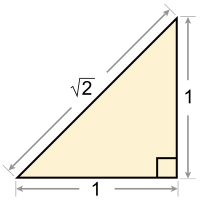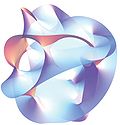|
| |
|
|
|
|
|
Geometry:Geometry (Ancient Greek: ?e?µet??a; geo- "earth", -metri "measurement") "Earth-measuring" is a branch of mathematics concerned with questions of shape, size, relative position of figures, and the properties of space. Geometry is one of the oldest mathematical sciences. Initially a body of practical knowledge concerning lengths, areas, and volumes, in the 3rd century BC geometry was put into an axiomatic form by Euclid, whose treatment—Euclidean geometry—set a standard for many centuries to follow. Archimedes developed ingenious techniques for calculating areas and volumes, in many ways anticipating modern integral calculus. The field of astronomy, especially mapping the positions of the stars and planets on the celestial sphere and describing the relationship between movements of celestial bodies, served as an important source of geometric problems during the next one and a half millennia. A mathematician who works in the field of geometry is called a geometer. The introduction of coordinates by René Descartes and the concurrent development of algebra marked a new stage for geometry, since geometric figures, such as plane curves, could now be represented analytically, i.e., with functions and equations. This played a key role in the emergence of infinitesimal calculus in the 17th century. Furthermore, the theory of perspective showed that there is more to geometry than just the metric properties of figures: perspective is the origin of projective geometry. The subject of geometry was further enriched by the study of intrinsic structure of geometric objects that originated with Euler and Gauss and led to the creation of topology and differential geometry. In Euclid's time there was no clear distinction between physical space and geometrical space. Since the 19th-century discovery of non-Euclidean geometry, the concept of space has undergone a radical transformation, and the question arose which geometrical space best fits physical space. With the rise of formal mathematics in the 20th century, also 'space' (and 'point', 'line', 'plane') lost its intuitive contents, so today we have to distinguish between physical space, geometrical spaces (in which 'space', 'point' etc. still have their intuitive meaning) and abstract spaces. Contemporary geometry considers manifolds, spaces that are considerably more abstract than the familiar Euclidean space, which they only approximately resemble at small scales. These spaces may be endowed with additional structure, allowing one to speak about length. Modern geometry has multiple strong bonds with physics, exemplified by the ties between pseudo-Riemannian geometry and general relativity. One of the youngest physical theories, string theory, is also very geometric in flavour. While the visual nature of geometry makes it initially more accessible than other parts of mathematics, such as algebra or number theory, geometric language is also used in contexts far removed from its traditional, Euclidean provenance (for example, in fractal geometry and algebraic geometry).[1]
[edit] Overview
Visual proof of the Pythagorean theorem for the (3, 4, 5) triangle as in the Chou Pei Suan Ching 500–200 BC.
The recorded development of geometry spans more than two millennia. It is hardly surprising that perceptions of what constituted geometry evolved throughout the ages. [edit] Practical geometryGeometry originated as a practical science concerned with surveying, measurements, areas, and volumes. Among the notable accomplishments one finds formulas for lengths, areas and volumes, such as Pythagorean theorem, circumference and area of a circle, area of a triangle, volume of a cylinder, sphere, and a pyramid. A method of computing certain inaccessible distances or heights based on similarity of geometric figures is attributed to Thales. Development of astronomy led to emergence of trigonometry and spherical trigonometry, together with the attendant computational techniques. [edit] Axiomatic geometry
An illustration of Euclid's parallel postulate
See also: Euclidean geometry
Euclid took a more abstract approach in his Elements, one of the most influential books ever written. Euclid introduced certain axioms, or postulates, expressing primary or self-evident properties of points, lines, and planes. He proceeded to rigorously deduce other properties by mathematical reasoning. The characteristic feature of Euclid's approach to geometry was its rigor, and it has come to be known as axiomatic or synthetic geometry. At the start of the 19th century the discovery of non-Euclidean geometries by Gauss, Lobachevsky, Bolyai, and others led to a revival of interest, and in the 20th century David Hilbert employed axiomatic reasoning in an attempt to provide a modern foundation of geometry. [edit] Geometric constructionsMain article: Compass and straightedge constructions
Ancient scientists paid special attention to constructing geometric objects that had been described in some other way. Classical instruments allowed in geometric constructions are those with compass and straightedge. However, some problems turned out to be difficult or impossible to solve by these means alone, and ingenious constructions using parabolas and other curves, as well as mechanical devices, were found. [edit] Numbers in geometry
The Pythagoreans discovered that the sides of a triangle could have incommensurable lengths.
In ancient Greece the Pythagoreans considered the role of numbers in geometry. However, the discovery of incommensurable lengths, which contradicted their philosophical views, made them abandon (abstract) numbers in favor of (concrete) geometric quantities, such as length and area of figures. Numbers were reintroduced into geometry in the form of coordinates by Descartes, who realized that the study of geometric shapes can be facilitated by their algebraic representation. Analytic geometry applies methods of algebra to geometric questions, typically by relating geometric curves and algebraic equations. These ideas played a key role in the development of calculus in the 17th century and led to discovery of many new properties of plane curves. Modern algebraic geometry considers similar questions on a vastly more abstract level. [edit] Geometry of positionMain articles: Projective geometry and Topology
Even in ancient times, geometers considered questions of relative position or spatial relationship of geometric figures and shapes. Some examples are given by inscribed and circumscribed circles of polygons, lines intersecting and tangent to conic sections, the Pappus and Menelaus configurations of points and lines. In the Middle Ages new and more complicated questions of this type were considered: What is the maximum number of spheres simultaneously touching a given sphere of the same radius (kissing number problem)? What is the densest packing of spheres of equal size in space (Kepler conjecture)? Most of these questions involved 'rigid' geometrical shapes, such as lines or spheres. Projective, convex and discrete geometry are three sub-disciplines within present day geometry that deal with these and related questions. Leonhard Euler, in studying problems like the Seven Bridges of Königsberg, considered the most fundamental properties of geometric figures based solely on shape, independent of their metric properties. Euler called this new branch of geometry geometria situs (geometry of place), but it is now known as topology. Topology grew out of geometry, but turned into a large independent discipline. It does not differentiate between objects that can be continuously deformed into each other. The objects may nevertheless retain some geometry, as in the case of hyperbolic knots. [edit] Geometry beyond EuclidFor nearly two thousand years since Euclid, while the range of geometrical questions asked and answered inevitably expanded, basic understanding of space remained essentially the same. Immanuel Kant argued that there is only one, absolute, geometry, which is known to be true a priori by an inner faculty of mind: Euclidean geometry was synthetic a priori.[2] This dominant view was overturned by the revolutionary discovery of non-Euclidean geometry in the works of Gauss (who never published his theory), Bolyai, and Lobachevsky, who demonstrated that ordinary Euclidean space is only one possibility for development of geometry. A broad vision of the subject of geometry was then expressed by Riemann in his inauguration lecture Über die Hypothesen, welche der Geometrie zu Grunde liegen (On the hypotheses on which geometry is based), published only after his death. Riemann's new idea of space proved crucial in Einstein's general relativity theory and Riemannian geometry, which considers very general spaces in which the notion of length is defined, is a mainstay of modern geometry. [edit] DimensionWhere the traditional geometry allowed dimensions 1 (a line), 2 (a plane) and 3 (our ambient world conceived of as three-dimensional space), mathematicians have used higher dimensions for nearly two centuries. Dimension has gone through stages of being any natural number n, possibly infinite with the introduction of Hilbert space, and any positive real number in fractal geometry. Dimension theory is a technical area, initially within general topology, that discusses definitions; in common with most mathematical ideas, dimension is now defined rather than an intuition. Connected topological manifolds have a well-defined dimension; this is a theorem (invariance of domain) rather than anything a priori. The issue of dimension still matters to geometry, in the absence of complete answers to classic questions. Dimensions 3 of space and 4 of space-time are special cases in geometric topology. Dimension 10 or 11 is a key number in string theory. Exactly why is something to which research may bring a satisfactory geometric answer. [edit] SymmetryThe theme of symmetry in geometry is nearly as old as the science of geometry itself. The circle, regular polygons and platonic solids held deep significance for many ancient philosophers and were investigated in detail by the time of Euclid. Symmetric patterns occur in nature and were artistically rendered in a multitude of forms, including the bewildering graphics of M. C. Escher. Nonetheless, it was not until the second half of 19th century that the unifying role of symmetry in foundations of geometry had been recognized. Felix Klein's Erlangen program proclaimed that, in a very precise sense, symmetry, expressed via the notion of a transformation group, determines what geometry is. Symmetry in classical Euclidean geometry is represented by congruences and rigid motions, whereas in projective geometry an analogous role is played by collineations, geometric transformations that take straight lines into straight lines. However it was in the new geometries of Bolyai and Lobachevsky, Riemann, Clifford and Klein, and Sophus Lie that Klein's idea to 'define a geometry via its symmetry group' proved most influential. Both discrete and continuous symmetries play prominent role in geometry, the former in topology and geometric group theory, the latter in Lie theory and Riemannian geometry. A different type of symmetry is the principle of duality in for instance projective geometry (see Duality (projective geometry)). This is a meta-phenomenon which can roughly be described as: replace in any theorem point by plane and vice versa, join by meet, lies-in by contains, and you will get an equally true theorem. A similar and closely related form of duality appeares between a vector space and its dual space. [edit] Modern geometryModern geometry is the title of a popular textbook by Dubrovin, Novikov and Fomenko first published in 1979 (in Russian). At close to 1000 pages, the book has one major thread: geometric structures of various types on manifolds and their applications in contemporary theoretical physics. A quarter century after its publication, differential geometry, algebraic geometry, symplectic geometry and Lie theory presented in the book remain among the most visible areas of modern geometry, with multiple connections with other parts of mathematics and physics. [edit] History of geometryMain article: History of geometry

Woman teaching geometry. Illustration at the beginning of a medieval translation of Euclid's Elements, (c.1310)
The earliest recorded beginnings of geometry can be traced to ancient Mesopotamia, Egypt, and the Indus Valley from around 3000 BCE. Early geometry was a collection of empirically discovered principles concerning lengths, angles, areas, and volumes, which were developed to meet some practical need in surveying, construction, astronomy, and various crafts. The earliest known texts on geometry are the Egyptian Rhind Papyrus and Moscow Papyrus, the Babylonian clay tablets, and the Indian Shulba Sutras, while the Chinese had the work of Mozi, Zhang Heng, and the Nine Chapters on the Mathematical Art, edited by Liu Hui. Until relatively recently (i.e. the last 200 years), the teaching and development of geometry in Europe and the Islamic world was based on Greek geometry.[3][4] Euclid's Elements (c. 300 BCE) was one of the most important early texts on geometry, in which he presented geometry in an ideal axiomatic form, which came to be known as Euclidean geometry. The treatise is not, as is sometimes thought, a compendium of all that Hellenistic mathematicians knew about geometry at that time; rather, it is an elementary introduction to it;[5] Euclid himself wrote eight more advanced books on geometry. We know from other references that Euclid’s was not the first elementary geometry textbook, but the others fell into disuse and were lost.[citation needed] In the Middle Ages, mathematics in medieval Islam contributed to the development of geometry, especially algebraic geometry[6][7][unreliable source?] and geometric algebra.[8] Al-Mahani (b. 853) conceived the idea of reducing geometrical problems such as duplicating the cube to problems in algebra.[7] Thabit ibn Qurra (known as Thebit in Latin) (836–901) dealt with arithmetical operations applied to ratios of geometrical quantities, and contributed to the development of analytic geometry.[9] Omar Khayyám (1048–1131) found geometric solutions to cubic equations, and his extensive studies of the parallel postulate contributed to the development of non-Euclidian geometry.[10][unreliable source?] The theorems of Ibn al-Haytham (Alhazen), Omar Khayyam and Nasir al-Din al-Tusi on quadrilaterals, including the Lambert quadrilateral and Saccheri quadrilateral, were the first theorems on elliptical geometry and hyperbolic geometry, and along with their alternative postulates, such as Playfair's axiom, these works had a considerable influence on the development of non-Euclidean geometry among later European geometers, including Witelo, Levi ben Gerson, Alfonso, John Wallis, and Giovanni Girolamo Saccheri.[11] In the early 17th century, there were two important developments in geometry. The first, and most important, was the creation of analytic geometry, or geometry with coordinates and equations, by René Descartes (1596–1650) and Pierre de Fermat (1601–1665). This was a necessary precursor to the development of calculus and a precise quantitative science of physics. The second geometric development of this period was the systematic study of projective geometry by Girard Desargues (1591–1661). Projective geometry is the study of geometry without measurement, just the study of how points align with each other. Two developments in geometry in the 19th century changed the way it had been studied previously. These were the discovery of non-Euclidean geometries by Lobachevsky, Bolyai and Gauss and of the formulation of symmetry as the central consideration in the Erlangen Programme of Felix Klein (which generalized the Euclidean and non Euclidean geometries). Two of the master geometers of the time were Bernhard Riemann, working primarily with tools from mathematical analysis, and introducing the Riemann surface, and Henri Poincaré, the founder of algebraic topology and the geometric theory of dynamical systems. As a consequence of these major changes in the conception of geometry, the concept of "space" became something rich and varied, and the natural background for theories as different as complex analysis and classical mechanics. [edit] Contemporary geometry[edit] Euclidean geometryEuclidean geometry has become closely connected with computational geometry, computer graphics, convex geometry, discrete geometry, and some areas of combinatorics. Momentum was given to further work on Euclidean geometry and the Euclidean groups by crystallography and the work of H. S. M. Coxeter, and can be seen in theories of Coxeter groups and polytopes. Geometric group theory is an expanding area of the theory of more general discrete groups, drawing on geometric models and algebraic techniques. [edit] Differential geometryDifferential geometry has been of increasing importance to mathematical physics due to Einstein's general relativity postulation that the universe is curved. Contemporary differential geometry is intrinsic, meaning that the spaces it considers are smooth manifolds whose geometric structure is governed by a Riemannian metric, which determines how distances are measured near each point, and not a priori parts of some ambient flat Euclidean space. [edit] Topology and geometry
A thickening of the trefoil knot
The field of topology, which saw massive development in the 20th century, is in a technical sense a type of transformation geometry, in which transformations are homeomorphisms. This has often been expressed in the form of the dictum 'topology is rubber-sheet geometry'. Contemporary geometric topology and differential topology, and particular subfields such as Morse theory, would be counted by most mathematicians as part of geometry. Algebraic topology and general topology have gone their own ways. [edit] Algebraic geometry
Quintic Calabi–Yau threefold
The field of algebraic geometry is the modern incarnation of the Cartesian geometry of co-ordinates. From late 1950s through mid-1970s it had undergone major foundational development, largely due to work of Jean-Pierre Serre and Alexander Grothendieck. This led to the introduction of schemes and greater emphasis on topological methods, including various cohomology theories. One of seven Millennium Prize problems, the Hodge conjecture, is a question in algebraic geometry. The study of low dimensional algebraic varieties, algebraic curves, algebraic surfaces and algebraic varieties of dimension 3 ("algebraic threefolds"), has been far advanced. Gröbner basis theory and real algebraic geometry are among more applied subfields of modern algebraic geometry. Arithmetic geometry is an active field combining algebraic geometry and number theory. Other directions of research involve moduli spaces and complex geometry. Algebro-geometric methods are commonly applied in string and brane theory. [edit] See also[edit] Lists
[edit] Related topics
[edit] References[edit] Notes
[edit] Bibliography
[edit] External links
| ||||||||||||||||||||||||||||||